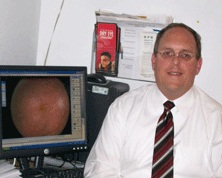By Eric Botts, OD
Understanding when to bill medical insurance versus routine billing can make the difference between profitability and potential revenue loss. If you choose to bill medical insurance for services, explain to your patients why.
Billing a patient’s medical insurance, rather than their eyecare insurance, is warranted in many cases. In fact, recognizing when to go this route is a powerful practice-builder. One difficulty that ODs have in adopting this procedure is that patients often misunderstand why you are billing them medically. That is a situation you need to manage well because it also establishes that you provide a higher level of care than the patient may imagine.
In many cases, using their routine benefit means less out-of-pocket expense to the patient–and in today’s economy patients want to save every dollar they can. However, if the exam is determined to be medical by you the doctor then it is necessary to explain to the patient that the exam will be submitted to their medical insurance carrier.
Fortunately, this scenario will become easier once all of us accept the responsibility to step up and be the medical optometrists we were trained to be. Anyone believing that the future of optometry will only be refractive in nature needs a healthy dose of reality. Medical optometry is here and will be a major part of optometry now and into the future. So let me offer some suggestions on how to start the conversation with your patient.
The conversation can begin as early as when the patient calls to schedule the appointment. Ask the patient if they are diabetic and if their response is yes then explain that the exam will be medical due to their current history of diabetes which is a leading cause of blindness here is the US. Many health insurance plans today require notation in the patient record of the primary care doctor treating diabetes that a yearly dilated fundus exam was performed. This is also the time to ask for the patient’s insurance information so eligibility may be determined prior to the appointment.
When the patient enters your office, be sure to make copies of all insurance cards used by the patient. This is an excellent opportunity to plant the seed that you can do more than just prescribe eyeglasses and contact lenses, but also diagnose and treat many ocular diseases. Confirming eligibility benefits for both routine and medical benefits prior to appointments is necessary for efficient patient flow.
Confirming eligibility for health insurance plans may be quickly performed using many of the clearinghouses currently utilized for electronic claim submission. If that is not an option, many of the health insurance carriers also have web sites available that allow you to check patient eligibility. Navinet, Availity and several of the Medicare carriers have free web portal access to patient eligibility information. Checkmedicare.com is a pay-per-claim service that offers eligibility information as well.
It is appropriate to discuss with the patient fees associated with medical visits and procedures performed to diagnose ocular disease. Educating your patient on the services you provide is the responsibility of you and your staff and is a critical step in building a successful optometric practice. Explain to your patient why a retinal photo is necessary to document the presence of diabetic retinopathy or a threshold visual field and OCT scan are required to follow the progression of glaucoma, and the patient will return to your office for required follow-up care. Patients with ocular disease may become your most loyal patients resulting in patient referrals that build a successful practice.
Be Clear and Confident. Part of the confusion patients have about medical and routine optometric eyecare is derived from the ongoing confusion many doctors and staff have on the same topic. Doctors and staff need to be confident in their communications with patients on the care they provide. Medical and routine eye exams are as much the same as they are different, so doctors and staff misunderstandings spill over to the patient. Here is a brief explanation of terms:
Routine
Chief complaint or reason for visit
Refractive in nature
History
Elements of exam
Low or no medical decision-making
Primary diagnosis is refractive
Medical
Chief complaint (CC) or reason for visit
Medical necessity
History
Elements of exam
Medical decision-making
Medical diagnosis correlates with CC
The primary difference is the chief complaint (CC), decision-making and diagnosis. If the CC or primary diagnosis is refractive in nature then the exam is routine. If the CC involves medical necessity and correlates with a primary medical diagnosis then the exam is medical. Often the history and elements of the exam may be similar or even identical, so focus on the CC and diagnosis to differentiate routine from medical.
Another option to help your patient understand the difference is to use an intake form that explains when routine or medical insurance will be used and also that the decision is made by the doctor depending on the presentation and diagnosis of the patient. This form is presented to the patient prior to beginning the exam so they can read it and sign it to acknowledge their understanding of routine and health insurance benefits.
Remember, these conversations are necessary today because more and more patients are acquiring health and routine insurance. Fortunately, as more and more of our colleagues provide full-scope medical optometric care instead of giving away their medical services during a routine eye exam, the conversation will become less frequent because if we all share the same message with our patients they will quickly understand when their routine and medical eye benefits will be utilized.
Related ROB Articles
Examination Coding Clarification: Medical vs. Non-Medical vs. Routine
Insurance Credentialing: Enable More Patients to Use Vision Benefits
Enhance Vision Benefit Communication with Patients to Increase Revenues
Eric Botts, OD, is founder and president of OBC Billing Specialists, and president of InnovativeEyes, in Macomb, IL. To contact him: drvision@claimdoctor.net.





















